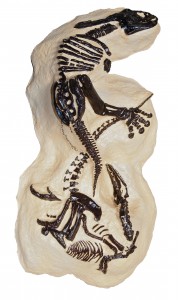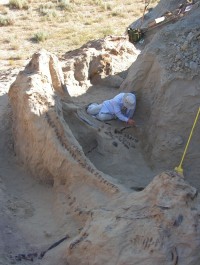 A pair of exceptional dinosaur fossils discovered on private land in Montana in 2006 will be going up for auction at Bonhams in New York on November 19th, and scientists aren’t too thrilled about it. The pre-sale estimate is $7 million to $9 million, an exorbitant sum for an institution, so the fossils and all the unique information they contain might be lost to science should they be snapped up by a private collector with deep pockets.
A pair of exceptional dinosaur fossils discovered on private land in Montana in 2006 will be going up for auction at Bonhams in New York on November 19th, and scientists aren’t too thrilled about it. The pre-sale estimate is $7 million to $9 million, an exorbitant sum for an institution, so the fossils and all the unique information they contain might be lost to science should they be snapped up by a private collector with deep pockets.
The fossils capture two extremely rare dinosaurs in what appears to be the moment they killed each other 67 millions years ago. The carnivore, Nanotyrannus lancensis, left some of his teeth in the skull and neck of the herbivore Chasmosaurine ceratopsian. In turn, Nanotyrannus’ chest and skull are crushed from a powerful blow to the side, perhaps a well-placed kick from Chasmosaurine. Nanotyrannus lancensis is either a relative of Tyrannosaurus Rex or a juvenile. This is one of only two examples of the species ever discovered so there’s still debate about whether it’s a separate pygmy tyrannosaur genus or a young T. Rex. Chasmosaurine ceratopsian is closely related to the Triceratops.
This is only the second known fossil to preserve two dinosaurs in a fight. In the other example the two dinosaurs are small, about the size of greyhounds, and they’re nowhere near as complete. The Montana dueling dinos are huge. They are both eight feet high, the ceratopsian 17 feet wide and the lancensis 22 feet wide. They are so well preserved that there are pockets of what could be skin from both animals still attached.
From the Bonhams press release:
The “Dueling Dinos” have the potential to radically advance modern paleontology, and illuminate the mysteries of life during the Cretaceous Age. Their superb preservation in fine-grain, loosely consolidated sandstone allowed them to remain intact despite the weight of the sediment that buried them. The specimens were removed in large, plaster-jacketed sections of earth, safeguarding the spatial relationships in which the bones were found. Both dinosaurs also exhibit extremely rare preserved soft (skin) tissue, offering spectacular possibilities for cellular research.
Additionally, the “Dueling Dinos” may hold the key to answering one of the most puzzling questions for paleontologists today. Presently, researchers are divided over whether Nanotyrannus’ are their own genus, or whether they are simply juvenile Tyrannosaurus Rexes. The Nanotyrannus involved in the “Dueling Dinos” is only the second example ever found, and by far the most complete, offering the best hope to date of answering this pressing scientific question.
 Unfortunately, selling them for multi-millions isn’t exactly a boon to science. I find it downright odd that the auction house would emphasize their scientific significance when publicizing their sale to the highest bidder. It’s not like the sellers, the ranchers who own the land in the Hell Creek sedimentary rock formation of Montana where the dueling dinosaurs were found, have stipulated that all buyers must make the fossils available for research. This sale could very well end all scientific investigation of the specimen.
Unfortunately, selling them for multi-millions isn’t exactly a boon to science. I find it downright odd that the auction house would emphasize their scientific significance when publicizing their sale to the highest bidder. It’s not like the sellers, the ranchers who own the land in the Hell Creek sedimentary rock formation of Montana where the dueling dinosaurs were found, have stipulated that all buyers must make the fossils available for research. This sale could very well end all scientific investigation of the specimen.
The owners did attempt to sell the fossils directly to museums before they put them up for auction, but their asking price was insane. The Smithsonian was given the chance to bid privately starting at around $15 million. They declined. The American Museum of Natural History received a similar offer which it too declined because of the exorbitant price and because it prefers to display dinosaurs excavated by the museum. The Field Museum of Chicago was also offered the duelers which it declined due to the expense, and this is the museum that paid $8.36 million at auction for Sue, the Tyrannosaurus Rex which currently holds the record for most expensive dinosaur ever sold.
Maybe one of those institutions who didn’t have $15 million might be able to scrape up half that for the auction, but those pre-sale estimates could easily be blown away in active bidding. Let’s just hope that whoever buys the fossils is willing to grant the scientific community access to it.